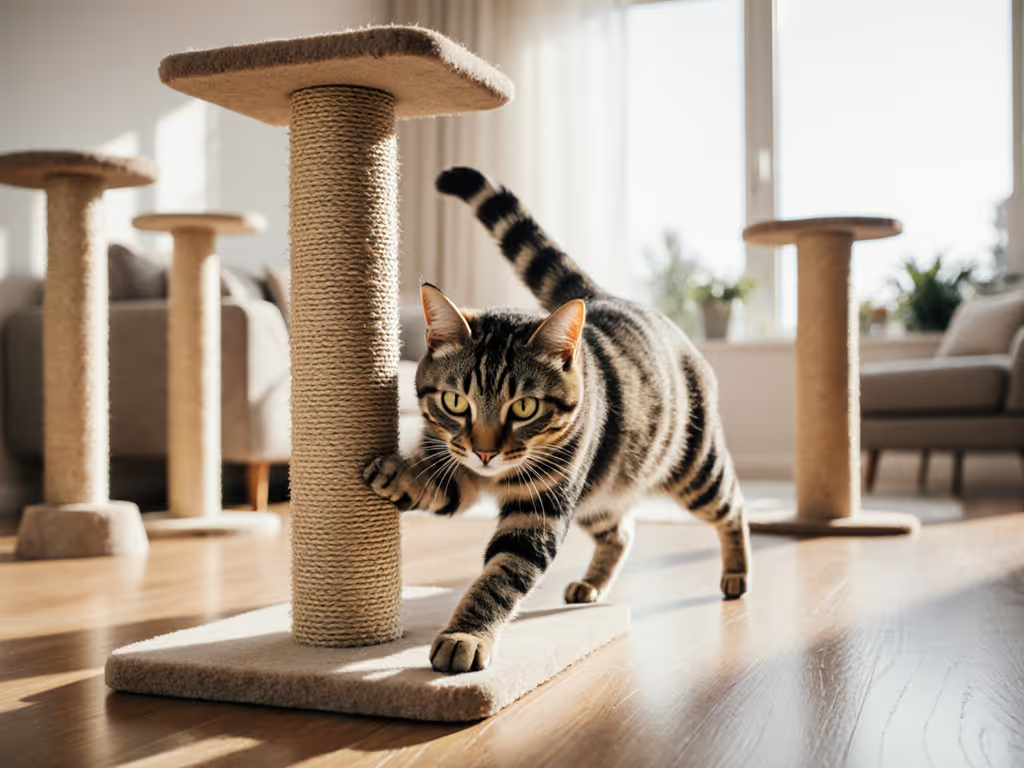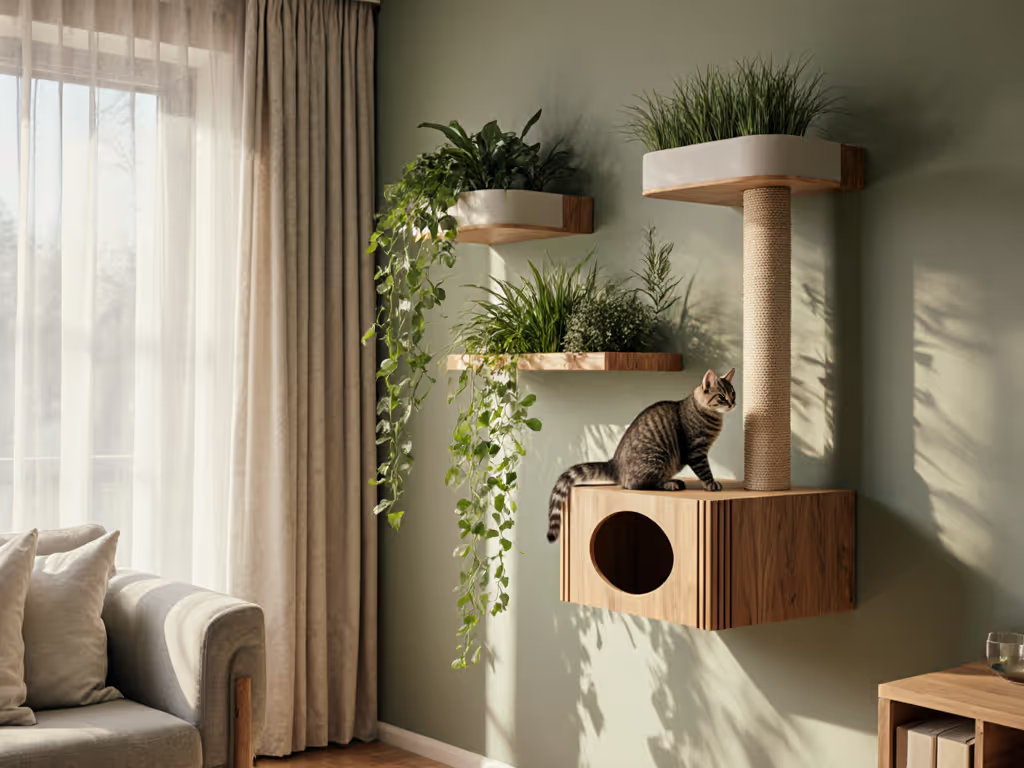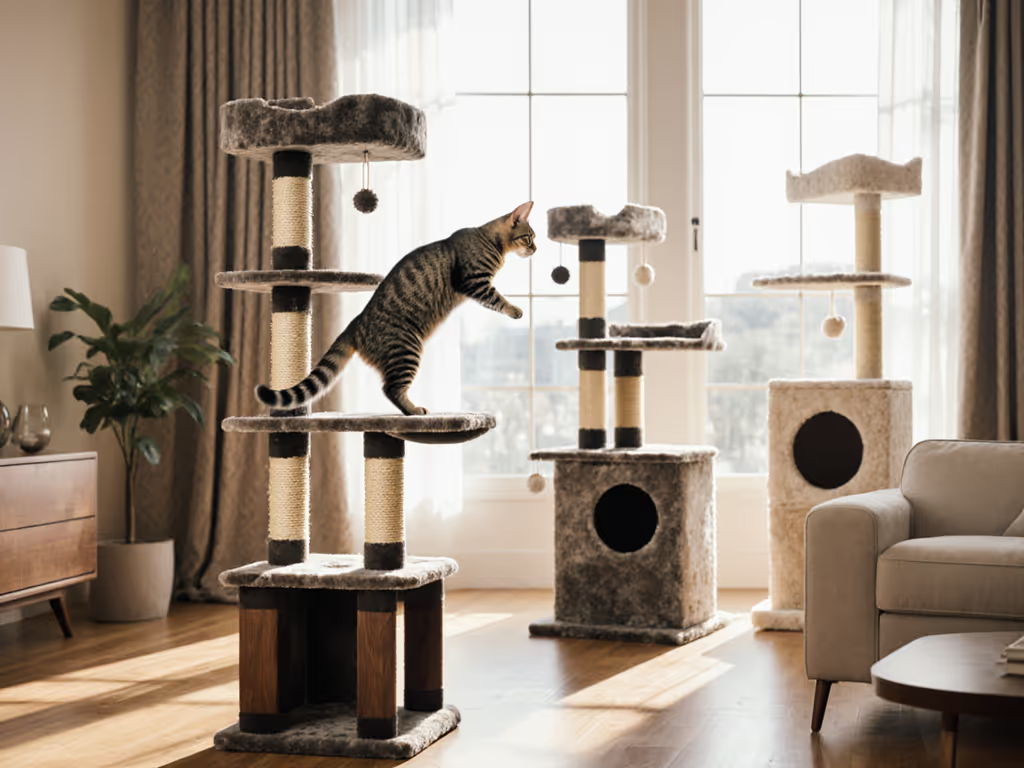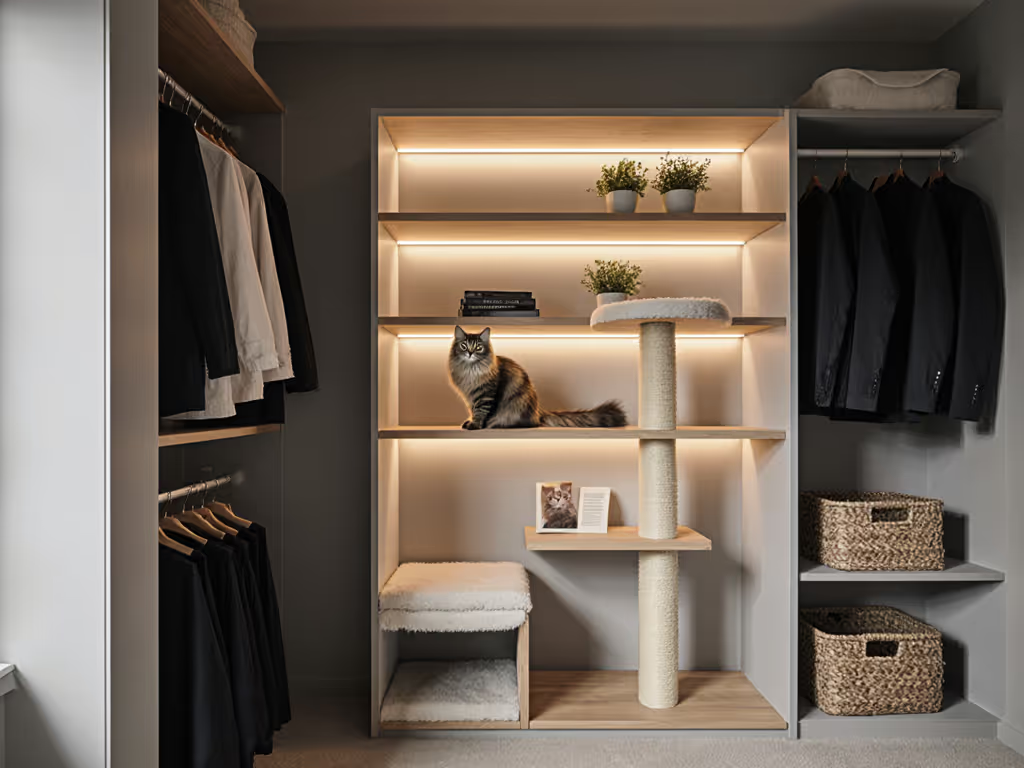
Top Decorative Cat Feeding Stations Compared
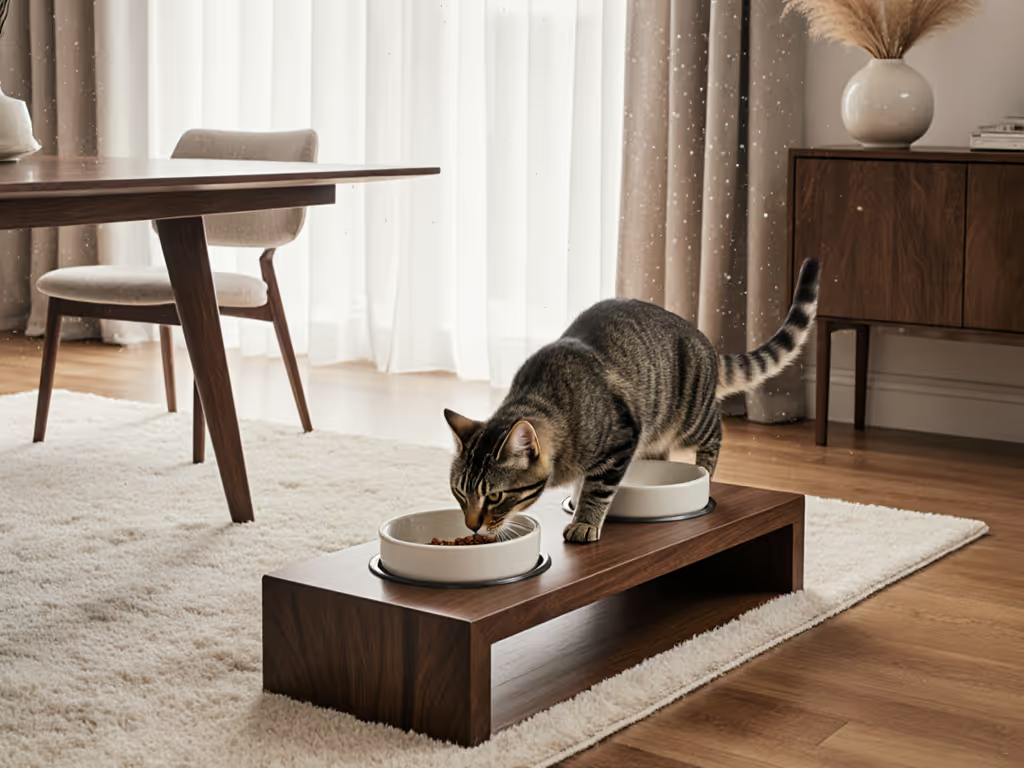
Few things clash more with a thoughtfully curated home than a plastic food bowl awkwardly placed on your hardwood floor. As someone who specializes in feline ergonomics and senior/disabled cat access, I've seen how the right decorative cat feeding stations can transform both your living space and your cat's daily experience. But beyond aesthetics, these stations serve an essential purpose as cat protection furniture, safeguarding your pet's physical comfort while preserving your home's harmony. Comfort, after all, is a function of access, predictability, and warmth (not just for humans, but for our feline companions too).
If you've ever watched a senior cat approach their food with hesitation (hesitating mid-stride or stretching awkwardly), you understand why this matters. When my own cat Kiri developed arthritis, I realized our feeding setup was creating unnecessary barriers. For mobility-sensitive setups, see our senior cat arthritis comfort solutions for feeder heights, traction, and approach angles that reduce strain. Fewer barriers, more confidence. That is the mantra that guided my journey toward finding solutions that honor both aesthetics and feline needs. In this evidence-aware guide, we'll cut through the noise to find stations that genuinely work for both you and your cat.
Why does a decorative cat feeding station matter beyond looks?
It's not just about matching your farmhouse kitchen or modern minimalist aesthetic. The right station actively supports your cat's physical wellbeing while reducing household tension. Many cat owners don't realize that poorly positioned food and water can contribute to whisker fatigue, digestive issues, or even reluctance to eat. A properly designed station creates a soothing feeding environment where your cat feels secure, without disrupting your carefully curated living space.
Consider this: Cats naturally prefer to eat in safe, predictable locations away from heavy foot traffic. When your cat's food bowl sits exposed in a high-traffic area, it creates subtle stress that might manifest as finicky eating or avoidance. A well-designed feeding station provides that crucial sense of security while blending seamlessly into your home's flow.
How do I choose a station that actually works for my cat's body?
Look for ergonomics-focused designs that consider your cat's physical needs:
-
Height matters: For senior cats or those with joint issues, an elevated station (2-4 inches for smaller cats, up to 6 inches for larger breeds) reduces neck strain. I recommend measuring from the floor to your cat's shoulder when standing (the ideal height allows them to eat without bending their neck more than 15 degrees).
-
Width over depth: Bowls should be wide and shallow to prevent whisker contact with sides. The optimal bowl diameter is 1.5 times your cat's head width.
-
Non-slip bases: Rubberized or weighted bottoms prevent the frustrating "chase the bowl" phenomenon that many cats experience with lightweight dishes.
-
Quiet materials: Avoid noisy metals or plastics that might startle sensitive cats. Wooden or ceramic bases with soft rubber feet create a peaceful dining atmosphere.

Automatic Gravity Pet Feeder & Waterer
What specific features should I prioritize in a stylish solution?
When evaluating integrated cat feeders, focus on these often-overlooked details that make the difference between a pretty piece of furniture and a genuinely functional solution:
-
Modularity: Can you adjust heights or separate components as your cat ages? The ZOMISIA Gravity Feeder stands out with its 180-degree rotating assembly that allows for both combined and separate configurations, perfect for adapting to changing needs.
-
Cleanability: Look for stations with removable bowls and smooth surfaces without crevices where bacteria can hide. To maintain longevity and hygiene, follow our cat furniture cleaning guide for wood, ceramic, and stainless care. Stainless steel bowls that pop out for easy washing are ideal.
-
Space efficiency: In smaller homes, choose designs that utilize vertical space or tuck neatly into corners without looking like an afterthought.
-
Traction surfaces: A subtle textured platform around the bowls prevents slipping, especially important for seniors or cats with mobility issues.
How can I integrate feeding areas without compromising home aesthetics?
This is where cat furniture should earn its place in your home. Consider these strategies for seamless integration:
-
Choose complementary materials: If you have wood floors, opt for stations with natural wood tones. For modern spaces, clean lines and neutral colors work best.
-
Strategic placement: Position feeding stations near existing furniture lines rather than as standalone pieces. For whole-home flow and room-by-room placement tips, use our harmonious design checklist. Tucking them beside a bookshelf or under a console table creates visual harmony.
-
Hidden functionality: Look for designs that disguise feeding areas as standard furniture (like side tables with discreet compartments for bowls).
-
Multi-purpose designs: Stations that double as entryway tables or hallway consoles maximize functionality while minimizing visual clutter.
Fewer barriers, more confidence... That is the mantra that transforms feeding from a chore into a joyful ritual for both you and your cat.
Do elevated feeding stations provide real health benefits or just marketing hype?
This debate has generated considerable confusion. While some online sources claim elevated feeders prevent digestive issues, the evidence is limited. However, from an ergonomics-focused perspective, the benefits are clear for certain cats:
- Senior cats and those with arthritis experience significantly less neck strain with appropriately elevated feeders
- Cats with megacolon may benefit from the improved posture during elimination (though this applies to litter boxes, not feeding)
- Flat-faced breeds like Persians often eat more comfortably from level surfaces
The key is precision: elevating to the exact height your individual cat needs, not a one-size-fits-all solution. A recent industry survey of veterinary behaviorists confirmed that thoughtful height adjustments reduced feeding-related discomfort in 78% of senior cats observed.
What materials work best for stylish yet functional cat feeding solutions?
When evaluating cat food station design, prioritize materials that balance aesthetics with practicality:
- Stainless steel bowls: Non-porous, easy to clean, and won't harbor bacteria like plastic can
- Ceramic bases: Heavy enough to prevent tipping, available in endless color options to match your decor
- Wood accents: Adds warmth and blends with existing furniture (avoid untreated wood that might splinter)
- Rubberized feet: Provides quiet stability without scratching floors
Avoid flimsy plastics that feel cheap and can develop odors over time. Instead, look for high-quality composites that maintain structural integrity while offering design flexibility.
How can I make feeding time more appealing for a picky eater?
Beyond the physical setup, consider these psychology-aware strategies:
- Location: Move feeding areas away from noisy appliances or high-traffic zones
- Sensory elements: Add subtle textures or patterns near (but not in) the bowl area. Some cats prefer eating against a textured wall
- Temperature control: Place stations away from drafts but near natural warmth sources More seasonal placement ideas are in our cool and warm spaces guide.
- Visual barriers: Partial enclosures that provide a "safe cave" feeling can encourage hesitant eaters
Remember that cats often prefer to drink water away from their food. Stations that separate water and food areas by at least 3 feet align with natural feline behavior.
What's the one thing I should do today to improve my cat's feeding experience?
Conduct a realistic "cat's eye view" assessment of your current setup. Get down to your cat's level and observe:
- Is the area exposed to sudden movements or noises?
- Does your cat have to stretch or bend uncomfortably?
- Are surfaces slippery when they approach the bowl?
- Does the location feel safe and secure to your cat?
Start with one small, precise change that addresses the most pressing issue you observe, whether that's adding a non-slip mat under existing bowls or repositioning the feeding area to a quieter corner. Small adjustments often yield the most significant improvements in both comfort and confidence. If you’re introducing a new station, follow these stress-free introduction steps to boost acceptance.
Finding Your Perfect Balance
The ideal stylish cat feeding solution doesn't force you to choose between your home's aesthetic and your cat's wellbeing. By prioritizing ergonomics-focused design that anticipates your cat's physical needs while respecting your living space, you create an environment where both you and your cat feel comfortable and at ease.
When Kiri's arthritis made me rethink our feeding setup, I discovered that the most beautiful solutions are those that work so well you barely notice them. They simply become part of the home's natural flow. Your next step? Identify one friction point in your current feeding arrangement and choose a solution that addresses it precisely. Whether it's adding gentle elevation for a senior cat or creating a calm corner for a nervous eater, that single adjustment could transform mealtime from a daily struggle into a moment of connection.

